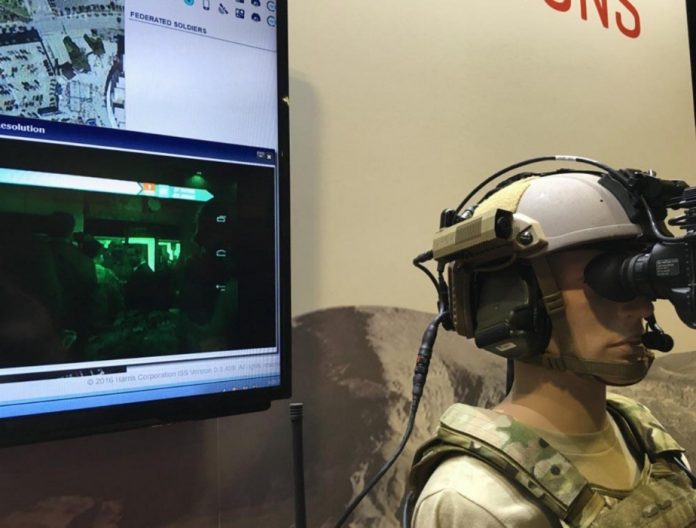
TAMPA, Fla. – To those trying to coordinate troop movements, communications and air support in the midst of a firefight, simple tasks can be almost impossible. Yet here at the 2016 Special Operations Forces Industry Conference, a number of companies are promoting technologies that may help cut some of that friction out of the chaos of ground combat.
Or add to it.
One technology, called Augmented Reality, basically takes a real-world image and layers it with a computer-generated one. For the soldier of the future, this means wearing a device that will show them a picture of the battlefield supplemented with digital information such as grid coordinates, the location of friendly troops and maybe in the near future, drone footage streamed from above.
The Augmented Reality system – developed by the communication company Harris and Dave Roberts at Applied Research Associates and showcased at this year’s industry conference – is still relatively bulky and adds roughly three pounds to an already six-pound helmet.
When worn, the user is presented with an interface that would be familiar to someone who had grown up playing video games. At the bottom of the display is a circle that moves as the user changes direction, simultaneously showing a compass heading and the user’s current grid coordinate, or location. Blue circles elsewhere on the screen can indicate current objectives, personnel or aircraft.
Currently, the system is optimized only to be used at night, though Harris is working on a day optic. It is unclear how durable the system is and how much power it would need for constant use. The video feed from the goggles is broadcast from a handheld radio – and even when only transmitting voice, it has a relatively short battery life.
Harris and Applied Research Associates market their Augmented Reality system in conjunction with what Harris calls its Integrated Soldier System, a package that is sold mostly to foreign customers and isn’t in use by U.S. forces. Harris, however, outfits the U.S. military with radio equipment, including satellite communications.
While promising, the setup is still problematic. Goggles, cameras and smartphones add weight to a soldier’s gear – equipment that has to be hauled in and out of vehicles and through the rigors of combat. According to Tim White, a spokesman for Harris, Augmented Reality along with the accompanying smartphone and goggles will probably be outfitted only on certain troops, such as leaders that might be working out of a vehicle or behind the front lines.
Yet despite the potential drawbacks, the Army is looking to integrate some aspects of Augmented Reality in its Nett Warrior system. The Nett Warrior is a 2010 reboot of the failed Land Warrior program. Started in the late 1980s, Land Warrior was an expensive attempt by the Army to outfit future soldiers with cameras and advanced small arms, but the program was canceled in 2007. Nett Warrior’s final dimensions are unclear, but it is likely to increase the individual soldier’s ability to receive and transmit data on the battlefield, according to Army documents posted online.

